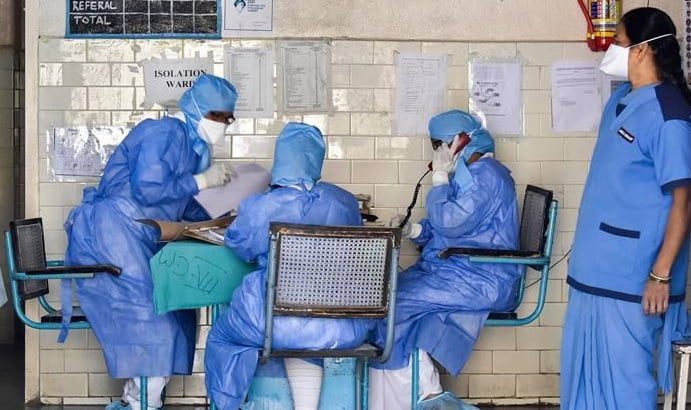
Covid: Why coronavirus pandemic exploded in India
Follow Us @
Covid: Why coronavirus infections exploded in India.
In early March, India’s health minister, Harsh Vardhan, declared that the country was in the “final phase” of the covid-19 pandemic. Vardhan also praised Prime Minister Narendra Modi’s leadership as an “example for the world in international cooperation”. In January, India began sending doses to foreign countries as part of its much-vaunted “vaccine diplomacy”..
Vardhan’s unbridled optimism was based on a sharp drop in notifications of infections. Since a peak of more than 93,000 cases per day, on average, in September, infections have steadily declined. In mid-February, India had an average of 11,000 cases a day. The seven-day moving average of daily deaths from the disease has dropped to less than 100. The euphoria of beating the virus had been growing since the end of last year. Politicians, lawmakers and part of the press believed that India was indeed out of danger. In December, central bank officials announced that India was “overturning the covid infection curve”. There was evidence, they said, in poetic terms,that the economy was “emerging out of the increasingly long winter shadows towards a place in the sun”. Modi was called a “vaccine guru”
In late February, India’s electoral authorities announced major elections in five states, where 186 million people could vote for positions in 824 seats. As of March 27, electoral polls would run for more than a month and, in the case of the state of West Bengal, they would be conducted in eight phases. The campaign began in full swing, with no protocols for safety and social distance. In mid-March, the authorities of cricket, a popular sport in India, allowed more than 130,000 fans, mostly without a mask, to watch two matches between India and England at the Narendra Modi stadium in Gujarat. In less than a month, things started to get complicated. India plunged into the grip of a second devastating wave of the virus and cities faced new lockdowns,
In mid-April, the country started to have an average of more than 100 thousand new cases per day. On Sunday (18/4), it registered more than 270 thousand cases and more than 1,600 deaths. If nothing is done, India could register more than 2,300 deaths every day in the first week of June, according to a report by the Indian task force for Lancet magazine’s covid-19.
Lockdown and blocking vaccine exports
India now faces a public health emergency. The capital, New Delhi, has just imposed a week-long lockdown after a record increase in cases that has overwhelmed the city’s health care system.
Social media feeds are full of funeral videos of covid-19 deaths in crowded cemeteries, relatives mourning the dead outside hospitals, long lines of ambulances carrying panting patients, morgues overflowing with dead, and patients, sometimes two by bed, in hospital corridors and halls.
There are frantic calls for help with beds, medicine, oxygen and tests. The drugs are being sold on the black market and test results are taking days. “For three hours, they, they didn’t tell me that my son was dead,” said a stunned mother in a video, sitting outside an ICU.
Even India’s gigantic vaccination effort is now suffering. In the beginning, the campaign suffered from controversy over the effectiveness of a local vaccine. Now, even with the country accelerating the campaign and administering more than 100 million doses until last week, there is a shortage of vaccines.
The Serum Institute of India, the largest vaccine manufacturer in the country – and the world – said it would not be able to increase supplies before June because it did not have sufficient financial resources to expand its capacity.
Thus, India temporarily suspended all exports of the Oxford vaccine with AstraZeneca, since doses were urgently needed within the country. It also allowed the importation of foreign vaccines. Even oxygen would possibly be imported now to meet the increased demand..
Meanwhile, almost in a parallel universe, far from death and despair, the richest cricket tournament in the world was played behind closed doors every night, tens of thousands of people followed their leaders at election rallies and others participated in the Hindu festival. by Kumbh Mela. “It’s going beyond the surreal,” Shiv Visvanathan, a sociology professor, told Shiv.
Why coronavirus infections exploded in India

Experts believe the government appears to have completely dropped the shuttlecock in connection with the second wave of infections that was about to hit India.
In mid-February, Tabassum Barnagarwala, a journalist for the Indian Express newspaper, signaled a seven-fold increase in new cases in parts of Maharashtra, India’s second most populous state. He also informed that, to check for the appearance of variants, samples of the infections had been sent for sequencing of the genome.
At the end of the month, the BBC reported the increase, questioning whether India was facing a new wave of covid-19. “We really do not know what is the cause of the increase. What is worrying is that entire families are being infected. This is a completely new trend,” replied Dr. Shyamsunder Nikam, a civil surgeon in an affected district in Maharashtra at the time.
Experts now say that extolling India’s achievement in “winning” the epidemic and declaring victory over the virus turned out to be cruelly premature. “As is typical in India, official arrogance, hyper-nationalism, populism and a large dose of bureaucratic incompetence have combined to create a crisis,” said Mihir Sharma, a Bloomberg columnist.
What caused the new wave of covid?
India’s second wave was fueled by people who let their guard down, attended weddings and social gatherings and mixed government messages, allowing for political rallies and religious gatherings
With the decline in infections, fewer people were taking the vaccines, slowing down the vaccination campaign, which aimed to inoculate 250 million people by the end of July. In mid-February, Bhramar Mukherjee, a biostatistician at the University of Michigan, tweeted that India needed to “speed up the vaccination campaign while the number of cases is low”. This opportunity was not taken advantage of.
“There was a sense of triumphalism,” said P Srinath Reddy, president of the Public Health Foundation of India. “Some felt that we had achieved collective immunity. Everyone wanted to go back to work. This narrative fell on many receptive ears and the few voices of caution were not answered,” he said.
The second wave may have been inevitable, but India could have “postponed or delayed and lessened its impact,” said Gautam Menon, a professor of physics and biology. Like many other countries, India should have started careful genomic surveillance in January to detect variants, noted Menon.
Some of these variants may be driving the increase. “We learned of new variants in February from reports from Maharashtra. This was initially denied by the authorities,” he added. “This was a significant turning point.”.

What are the lessons of this public health crisis?
On the one hand, India must learn not to declare victory over the virus prematurely and must put an end to triumphalism.
People should also learn to adapt to short-term local lockdowns in the event of inevitable future spikes of infection. Most epidemiologists predict more waves, as India is evidently far from achieving collective immunity and its vaccination rate remains low.
“We cannot freeze human life,” said Professor Reddy. “If we cannot physically distance ourselves in populous cities, we can at least ensure that everyone wears a suitable mask. And in a proper way. It is not too much to ask.”.
MORE@AFRILATEST
JOIN US ON FACEBOOK
-

 Fashion3 months ago
Fashion3 months agoVogue Arabia cover welcomes Salma Hayek in an interview with Penélope Cruz
-

 Football3 months ago
Football3 months agoVAR points out Diego Costa's offense against the fourth referee
-

 USA today entertainment3 months ago
USA today entertainment3 months agoBeyonce with the single “Break My Soul” leads on Spotify Brazil
-

 Health and Fitness3 months ago
Health and Fitness3 months agoVaccine against the reappearance of skin cancer enters final testing phase
-

 USA today entertainment3 months ago
USA today entertainment3 months agoSZA, Future and DJ Khaled come together in collaboration
-

 News3 months ago
News3 months agoParents of former player Waleswska are pressured by widower to pay rent for the house where they live
-

 USA today entertainment3 months ago
USA today entertainment3 months agoLarissa Luz and Linn da Quebrada enchant at the Multishow Awards with a tribute to Elza Soares.
-

 Good News TV series3 months ago
Good News TV series3 months agoThe shocking reason behind the decision not to show dead characters in The Last Of Us episode revealed

































